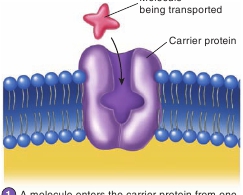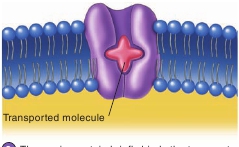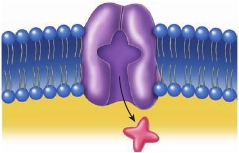CHAPTER 3 Cell Biology
67
the number of ions moving into a channel protein can exceed thecapacity of the channel, thus saturating the channel. Therefore,channel proteins exhibit specificity, competition, and saturation.
Carrier Proteins
Carrier proteins,
or
transporters,
are integral membrane proteinsthat move ions or molecules from one side of the plasma mem-brane to the other. Specific ions or molecules attach to bindingsites within the carrier protein. The binding of the specific ion ormolecule causes the carrier proteins to change shape and releasethe bound ion or molecule to the other side of the plasma mem-brane (figure 3.6). The carrier protein then resumes its originalshape and is available to transport more ions or molecules.
Molecule
Some carrier proteins transport one ion or molecule at a time,but other carrier proteins can transport more than one type of sub-stance at a time. Because of this difference, the movement of ionsor molecules by carrier proteins can be classified as uniport, sym-port, or antiport.
Uniport
is the movement of one specific ion ormolecule across the membrane.
Symport
(
cotransport
) is the move-ment of two different ions or molecules in the same direction acrossthe plasma membrane, whereas
antiport
(
countertransport
) is themovement of two different ions or molecules in opposite directionsacross the plasma membrane. Carrier proteins involved in thesetypes of movement are called
uniporters, symporters,
and
antiporters,
respectively.
ATP-Powered Pumps
ATP-powered pumps
are transport proteins that require cellularenergy to move specific ions or molecules from one side of theplasma membrane to the other. The activity of ATP-powered pumpsis fueled by the breakdown of adenosine triphosphate (ATP). Recallfrom chapter 2 that energy stored in ATP molecules is used topower many cellular activities. ATP-powered pumps have bindingsites, to which specific ions or molecules can bind, as well as abinding site for ATP. The breakdown of ATP to adenosine diphos-phate (ADP) releases energy, changing the shape of the protein,which moves the ion or molecule across the membrane (figure 3.7).

Receptor Proteins
1
A molecule enters the carrier protein from oneside of the plasma membrane.
Receptor proteins
are membrane proteins or glycoproteins thathave an exposed
receptor site
on the outer cell surface. Specificsubstances, such as chemical signals, can attach to the receptorsite. Many receptors and the chemical signals they bind are partof an intercellular communication system that coordinates cellactivities. One cell can release a chemical signal that diffuses toanother cell and binds to its receptor. The binding acts as a signalthat triggers a response. The same chemical signal would have noeffect on other cells that lacked the specific receptor molecule.

2
The carrier protein briefly binds the transportedmolecule.
Receptors Linked to Channel Proteins
Some membrane-bound receptors also help form ligand-gated ionchannels. The ion channels are composed of proteins that span theplasma membrane. Parts of one or more of the channel proteinsform receptors on the cell surface. When chemical signals, orligands, bind to these receptors, the combination alters thethree-dimensional structure of the proteins of the ion channels,causing the channels either to open or to close. The result is achange in the permeability of the plasma membrane to the specificions passing through the ion channels (figure 3.8). For example,acetylcholine released from nerve cells is a chemical signal thatcombines with membrane-bound receptors of skeletal muscle cells.The combination of acetylcholine molecules with the receptor sitesopens Na
+
channels in the plasma membrane. Consequently, theNa
+
diffuse into the skeletal muscle cells and trigger events thatcause the cells to contract.

3
The carrier protein changes shape and releasesthe transported molecule on the other side of theplasma membrane. The carrier protein thenchanges back to its original shape (go to step 1).
Receptors Linked to G Protein Complexes
Some membrane-bound receptor proteins function by altering theactivity of a
G protein complex
located on the inner surface of the
PROCESS FIGURE 3.6
Transport by a Carrier Protein